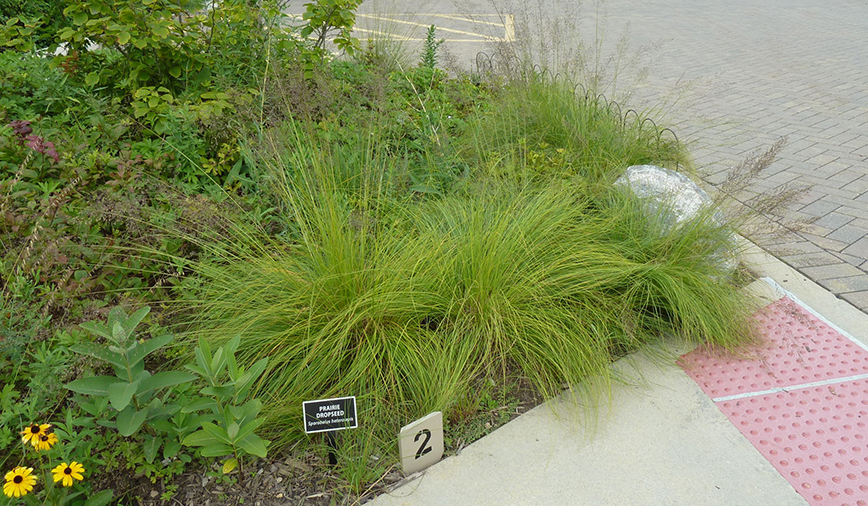Mmm…popcorn …
It’s one of my favorite snacks, and something I’ve had a hankering for for a while now. But it wasn’t until this week that I figured out why.
Each morning as I walk into work at Hickory Knolls, I get to look at a fabulous array of native plants carefully tended by our restoration team and their dedicated volunteers. I tend to park over by the goldenrods, then pass by the milkweed and St. John’s wort before turning onto the walkway that leads to the building.
It’s there at that turn that, Thursday, I realized why I have popcorn on the brain: Sporobolus heterolepis, or prairie dropseed.
Prairie dropseed is the sort of plant that makes you happy just by looking at it. Its leaf blades splay out at all angles, like bright green and gold fireworks popping out of the ground. Rising from this mass are assorted shoots, some with flowers, some without.
Now, when we talk about grass flowers, you’re not going to see the sort of showy display we’ve come to associate with that word. Forget colorful petals, or even sepals – the outer parts of a flower that usually are green and leaflike.
Grass flowers – more properly referred to as the inflorescence – have a lexicon all their own. But because botany was one of the courses where my eyes didn’t just roll back but actually went completely around inside my head, we’re going to restrict this discussion of plant morphology to include only the most important parts.
Prairie dropseed’s inflorescence consists of pyramid-shaped sprays called panicles. It’s here, inside tiny, need-a-hand-lens-to-see organs that the important – to the plant – business of reproduction occurs.
It’s also here that the important – to my nose – job of aroma production occurs.
What I’m not entirely sure about is what function that tantalizing fragrance fulfills. Prairie dropseed is wind pollinated, and therefore doesn’t need to use aroma to attract insects, mammals or other pollinating creatures. (Although, if it did, and if I were one such pollinator, the plant could count on overwhelming reproductive success.)
My one guess as to the role of that popcorn smell is that it may in fact act as a repellent to some animals. Prairie dropseed regularly appears on lists of plants considered “resistant,” though not completely immune, to the grazing tendencies of animals such as deer and rabbits.
What’s also interesting about this grass’s aromatic qualities, and what may support the aroma-as-repellent theory, is that not everyone perceives the smell the same way. Other writers have variously described prairie dropseed as smelling like cilantro, chemicals and, somewhat depressingly, popcorn that has been burned.
At any rate, I know for at least the next week or so, I can look forward to being greeted by the fragrance of one of my favorite foods each morning.
I’ll just need to make sure I’ve got some sassafras on hand. The aromatic leaves of this tree, when crushed, will let me wash down the smell of popcorn with the refreshing scent of, mmm,…root beer …
• Naturalists don’t live by scents alone, much as Pam Otto and her waistline wish that they could. When not waylaid by random aromas in the parking lot, she works as the manager of nature programs and interpretive services for the St. Charles Park District, and can be reached at 630-513-4346 or potto@stcparks.org.

